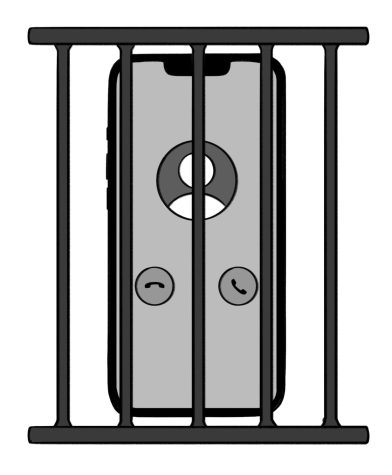Jail is for our brains, not our phones
May 9, 2023
Being the teenage girl I am, my whole life is stored on my iPhone. Keeping up with my family over text during the school day, scrolling through Snapchat and Instagram to see what my friends are doing or listening to my favorite artists on Apple Music are all activities that are vital parts of my daily routine. Born in the year of the iPhone’s invention, I’ve never known a life without my phone — something my mom, teachers and grandparents will never relate to. According to Axois, in 2021, a whopping 87 percent of students in the U.S. owned an iPhone, proving that dependency on the device can universally feel natural, and almost normal among American teens.
Educators see this dependency as a threat to student’s ability to focus in classrooms. However, teenagers naturally have short attention spans. According to Cross River Therapy, the average 16-year-old can pay attention for 32 – 48 minutes. On Mondays, all seven class periods are 45 minutes, just below the highest amount of time an average student could pay attention for. Naturally, when students feel uninterested in what’s happening in the classroom, they text a friend or scroll on a social media platform. To prevent distractions, phone jails were introduced in schools to discourage students from using their phones during class. This rule is too strict on students and teachers should not have access to our personal belongings. While on campus, students have the right to their own belongings, and unless a phone causes issues in the classroom, schools shouldn’t take away that right to have our own possessions.
During the 21st century, communication is key, especially for students. While at school, if a student doesn’t feel well, or needs to contact their parents when they’re getting picked up, they need a device to coordinate with them. Along with communication, if a student is in a dangerous situation they should hav

e access to their phone for safety. Just last year, 51 school shootings occurred in the U.S. that involved an injury or death. If a lockdown for a school shooting at Redwood were to take place, students should have easy access to their phones to alert adults of their situation and try to get to safety. According to Education Week, Sarah Pancost, a Michigan teacher who experienced gun violence at school herself, says that phones are essential safety tools. Phone jails may be easily accessible, but in a dire situation like that, students and teachers shouldn’t have another thing to worry about.
Phones have many other beneficial features that add to the classroom environment. Many students rely on apps on their phones to help them in school. Educational games such as Quizlet or Kahoot are great ways to review material and prepare for tests. Ever since elementary school, Kahoot has been a big part of all my classes and according to Kahoot, nine million teachers use it globally.
Music can also be a big part of the educational process. Active engagement with music can impact how the brain processes information, enhancing the perception of language and speech and improving our ability to communicate with others. Enjoying music can magnify a student’s comprehension, so teens should be able to access their phones for music during class.
According to the U.S. Department of Education, experiencing calming music can reduce aggressive behavior and feelings of anxiety and stress. Focusing on my schoolwork is something I often struggle with, but hitting shuffle on my favorite playlist will calm me down, allowing me to focus on one thing at a time.
On behalf of the research done by Common Sense Media, a nonprofit organization that promotes safe technology and media for children, the average person picks up their phone more than 1,500 times per week, and once every five and a half minutes. Considering this data, school would hypothetically be the perfect place to disconnect. IPhones can be dangerous to people who struggle with staying focused because social media and phone apps are designed to draw your attention by offering immediate rewards. These factors can cause extreme addiction that can take over someone’s life. In a recent study done by Child Mind Institute, undergraduates who were asked to leave their phones in another room did better on cognitive tests than those asked to silence their phones, leaving them with the screen-side down on their desks or in a bag. However, in the experiment, even students who said they weren’t thinking consciously about their cell phones still experienced a loss in ability, which means some of this distraction is happening on an unconscious level.
Not everyone needs consistent surveillance on their phone usage; some students have healthy habits with their phones, so why force everyone to partake in something lacking positive effects? Rather than removing the issue altogether, schools need to teach healthy, non-dependent habits that are useful when it comes to extreme cell phone usage.
This situation can be easily fixed if teachers give all students a chance to have their phones available to them in class. This way, the teacher can decide which students are distracted by their phones too much, to which they can then have a conversation with the student to figure out the best solution for them. This solution demonstrates a more fair approach, because confiscation of a phone will only pertain to students who would benefit from it. Students know which personal tools best encourage their own success, and if phone usage is one of those tools, they should be able to prove their accountability before facing interference with a prioritized component of their lives.























